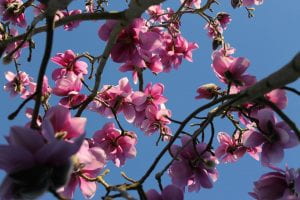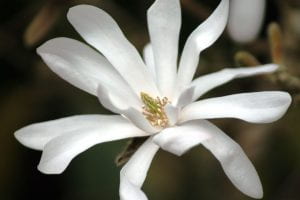By Andy Winfield

There’s nothing like watching nature mark off the times of the year, like familiar landmarks of a train journey to a favourite place, we know we’re moving away from winter when we see magnolias flower. The last time they flowered we couldn’t have known the year we had in store until they bloomed again, but here we are a year later and there they are with a comforting familiarity that the seasons bring, but for magnolias, they’ve seen it all before.
In the historical evolution of plants, flowering plants are relatively recent addition. The planet has had plants for around 850 million years, but for much of that time it was dominated by conifers, ferns and cycads. The first fossil evidence of flowers on plants dates to 125-100 million years ago; they now monopolise the plant kingdom making up 90% of all plant life. How flowering plants came to prevail so quickly perplexed Charles Darwin for one, who described it as an ‘abominable mystery’. Of all the flowering plants, Magnolia was a pioneer, with evidence of its presence on the planet 95 million years ago, a plant that had developed flowers before the earth had bees and dinosaurs plodded around. Beetles were the original magnolia pollinator, and the flower reflects this with a hardened carpel to protect from mandible damage and no nectar, as beetles were just interested in pollen.

Magnolia used to be prevalent in Europe before the Ice Age restricted it to South East Asia and North America where we see their native range today; the trees have influenced human culture from the Aztecs using magnolia flower as a flavouring for high profile priests, to the pharmaceutical use in traditional Chinese medicine. They are the state flower of Mississippi, city nickname of Houston, National flower of North Korea and official flowers of Shanghai and Gangnam to name a few formal appointments; but for most they’re a symbol of changing seasons, a sign that spring is winning the tug of war with winter.
This regular flowering of magnolia has been occurring through a multitude of earth’s crises and tribulations; mass extinctions, ice ages meteor strikes. Around 95 million flowering seasons, and today, when looking up into their branches, we see business as normal, the magnolia in flower.

